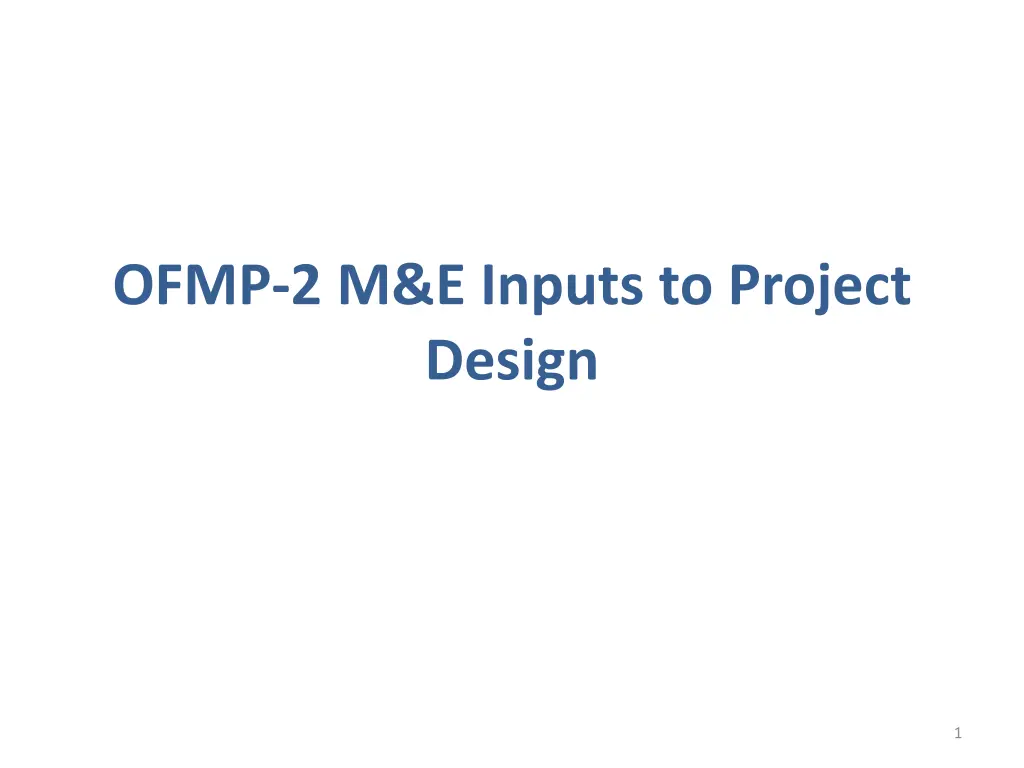
International Waters Management and Capacity Building
"Explore the objectives and activities of the GEF International Waters Focal Area, focusing on transboundary cooperation, marine ecosystems, and capacity building. Learn about project design, multi-state collaboration, and sustainability in managing water systems."
Download Presentation

Please find below an Image/Link to download the presentation.
The content on the website is provided AS IS for your information and personal use only. It may not be sold, licensed, or shared on other websites without obtaining consent from the author. If you encounter any issues during the download, it is possible that the publisher has removed the file from their server.
You are allowed to download the files provided on this website for personal or commercial use, subject to the condition that they are used lawfully. All files are the property of their respective owners.
The content on the website is provided AS IS for your information and personal use only. It may not be sold, licensed, or shared on other websites without obtaining consent from the author.
E N D
Presentation Transcript
OFMP-2 M&E Inputs to Project Design 1
GEF International Waters Focal Area Objectives GEF IW-1 - Transboundary Basins/ Aquifers: Catalyze multi-state cooperation to balance conflicting water uses in trans-boundary surface and groundwater basins while considering climatic variability and change GEF IW-2 - Large Marine Ecosystems/ Coasts: Catalyze multi-state cooperation to rebuild marine fisheries and reduce pollution of coasts and Large Marine Ecosystems (LMEs) while considering climatic variability and change GEF IW-3 - Capacity Building: Support foundational capacity building, portfolio learning, and targeted research needs for joint, ecosystem-based management of trans- boundary water systems GEF IW-4 - ABNJ Pilots: Promote effective management of Marine Areas Beyond National Jurisdiction (ABNJ) SP GEF IW SAP SP OFMP-1 SP OFMP-2 ABNJ 2
OFMP-2 5. PMU 2. sub-regional EBM 4. knowledge management 1. regional EBM 3. national EBM 4.1 multi- stakeholder participation 4.2 increased awareness EBM & CC impacts 1.2 LME adaptive management 2.1 rules applied & enforced 3.1 innovative CMMs 3.2 data & scientific systems 1.1 WCPFC CCMs 2.1.1 access systems implemented & enforced 3.2.1 effective data management 4.1.1 building NGO participation 4.2.1 website, communications / publications 1.2.1 CC vulnerability 3.1.1 national capacity building 1.1.1 CMMs prepared 3.1.2 improved legislation & rules 3.2.2 stock assessment training 1.2.2 CC impact on jurisdictions 4.1.2 project workshops 2.1.2 enhanced TVM 1.1.2 CMMs implemented 1.2.3 update of TDA & SAP 3.1.3 improved MCS 4.1.3 M&E & feedback 2.1.3 enhanced other 3.1.4 improved bycatch management Basic structure of OFMP-2 3
Implementing agency UNDP Implementing agency FAO OFMP-2 5. PMU 2. sub-regional EBM 4. knowledge management 1. regional EBM 3. national EBM 4.1 multi- stakeholder participation 4.2 increased awareness EBM & CC impacts 1.2 LME adaptive management 2.1 rules applied & enforced 3.1 innovative CMMs 3.2 data & scientific systems 1.1 WCPFC CCMs 2.1.1 access systems implemented & enforced 3.2.1 effective data management 4.1.1 building NGO participation 4.2.1 website, communications / publications 1.2.1 CC vulnerability 3.1.1 national capacity building 1.1.1 CMMs prepared 3.1.2 improved legislation & rules 3.2.2 stock assessment training 1.2.2 CC impact on jurisdictions 4.1.2 project workshops 2.1.2 enhanced TVM 1.1.2 CMMs implemented 1.2.3 update of TDA & SAP 3.1.3 improved MCS 4.1.3 M&E & feedback 2.1.3 enhanced other 3.1.4 improved bycatch management Executing Agency responsibilities 4
Delivery - FFA Delivery - SPC Delivery - FAO Delivery - other OFMP-2 5. PMU 2. sub-regional EBM 4. knowledge management 1. regional EBM 3. national EBM 4.1 multi- stakeholder participation 4.2 increased awareness EBM & CC impacts 1.2 LME adaptive management 2.1 rules applied & enforced 3.1 innovative CMMs 3.2 data & scientific systems 1.1 WCPFC CCMs 2.1.1 access systems implemented & enforced 3.2.1 effective data management 4.1.1 building NGO participation 4.2.1 website, communications / publications 1.2.1 CC vulnerability 3.1.1 national capacity building 1.1.1 CMMs prepared 3.1.2 improved legislation & rules 3.2.2 stock assessment training 1.2.2 CC impact on jurisdictions 4.1.2 project workshops 2.1.2 enhanced TVM 1.1.2 CMMs implemented 1.2.3 update of TDA & SAP 3.1.3 improved MCS 4.1.3 M&E & feedback 2.1.3 enhanced other 3.1.4 improved bycatch management Who expected to deliver what 5
OFMP-2 5. PMU 2. sub-regional EBM 4. knowledge management 1. regional EBM 3. national EBM 4.1 multi- stakeholder participation 4.2 increased awareness EBM & CC impacts 1.2 LME adaptive management 2.1 rules applied & enforced 3.1 innovative CMMs 3.2 data & scientific systems 1.1 WCPFC CCMs 2.1.1 access systems implemented & enforced 3.2.1 effective data management 4.1.1 building NGO participation 4.2.1 website, communications / publications 1.2.1 CC vulnerability 3.1.1 national capacity building 1.1.1 CMMs prepared 3.1.2 improved legislation & rules 3.2.2 stock assessment training 1.2.2 CC impact on jurisdictions 4.1.2 project workshops 2.1.2 enhanced TVM 1.1.2 CMMs implemented 1.2.3 update of TDA & SAP 3.1.3 improved MCS 4.1.3 M&E & feedback 2.1.3 enhanced other 3.1.4 improved bycatch management Sub-components that were found to be weak in OFMP-1 implementation 6
Project Objective: To support Pacific SIDS in meeting their obligations to implement and effectively enforce global, regional and sub-regional arrangements for the conservation and management of transboundary oceanic fisheries and thereby increasing the sustainable benefits derived from these fisheries GEF Implementing Agency UNDP FAO Executing Agency FFA SPC FFA FAO PNA stakeholders beneficiaries member countries Pacific SIDs TVM WWF-Pac PITIA 7
Reporting structures inception report baseline study mid-term evaluation terminal evaluation project design LogFrame reporting frequency performance measurement indicator type(s) IW outputs and outcomes system GEF IW indicator system annual annual, yearly UNDP activities, outputs, outcomes, spend output & outcome indicators annual, yearly FAO annual, quarterly, monthly activities, outputs, outcomes, spend output & outcome indicators FFA annual, quarterly, monthly operational management baseline & indicator data actual against planned; outputs; spend FFA SPC FAO PNA PITIA WWF-Pac 8 member countries
Indicator sets and reporting institutional capacity management outcomes measuring sticks / studies inception report annual reports market based instruments PIR / APR baseline report half yearly reports institutional capacity GEF IW TT mid-term evaluation monthly reports quality of decision-making binding private / 3rd sector terminal evaluation 9
